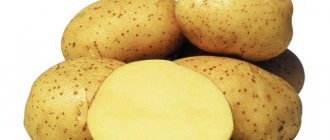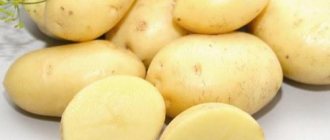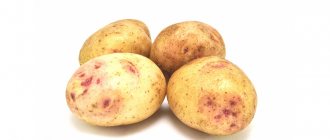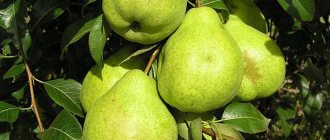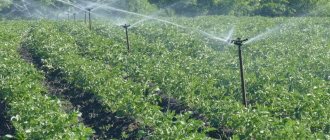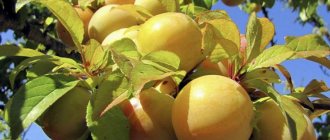Description of the variety
Early Morning potatoes are undemanding to care and soil. The variety is drought-resistant and is capable of producing two harvests per season.
Tall bushes, intermediate type; The stem is thick and erect. The plant is abundantly covered with medium-sized leaves. There are many hard hairs on the surface of the leaf blades. During the flowering period, corollas formed from lilac flowers form on the bushes.
Origin and development
Early morning potatoes were bred by Chelyabinsk breeders. To obtain this variety, scientists used Morning potatoes. Initially, they planned to increase taste and yield, but additionally paid attention to the plant’s immunity to diseases and pests. The Morning Early variety was included in the state register of the Russian Federation in 2021.
Chemical composition, trace elements and vitamins
It is almost impossible to imagine human nutrition without potatoes. If you eat a few of these vegetables a week, your body will be provided with all the necessary beneficial elements. 100 g contains 75 calories, of which 0.1 g fat, 1.9 g protein, 16.5 g carbohydrates and 14.2 g starch. Potatoes also contain:
- water;
- alimentary fiber;
- B vitamins - B1, B2, B3, B6, B9;
- vitamins C, PP, H;
- calcium;
- phosphorus;
- magnesium;
- iron;
- potassium;
- silicon;
- folic acid;
- sodium;
- chromium;
- selenium;
- iodine;
- tin;
- nickel;
- aluminum;
- cobalt;
- molybdenum;
- vanadium.
Ripening period
Early Morning potatoes are early varieties. The period from the appearance of full shoots to harvest takes about 60-75 days, but the first digging can be done already on the 45th day.
Productivity
Under one bush, up to 10 tubers weighing 100-190 g are formed. Vegetable growers harvest up to 250 centners of crop per hectare of planting.
Disease resistance
The Early Morning potato variety has strong immunity to diseases and pests such as:
- Potato cancer. This is a fungus that cannot survive drought or cold. Therefore, in the southern and northern regions, cancer does not affect plants. Zoosporangia of this fungus can live in the soil for many years, waiting for suitable conditions.
- Common scab. This fungus infects the vegetables themselves, which subsequently leads to the loss of taste and commercial characteristics of potatoes. The tubers taste bland and do not last long. The disease is difficult to identify, since in the initial stages it does not manifest itself in any way and does not affect the above-ground parts of plants.
- Colorado beetle. Adult pests and their larvae feed not only on green potato shoots, but also on tubers, especially in spring. The Colorado potato beetle larva is an insect with a curved back and a flattened bottom. The pest is large in size - up to 16 mm. As the larva grows and develops, the color of its shell changes from orange-red to orange with a yellowish tint. A characteristic difference between the Colorado potato beetle larvae is the presence of two rows of black dots on the sides.
Characteristics of tubers, description of appearance
Potatoes have an oval shape and a smooth surface. The peel is red in color, dense, with a mesh structure. When cut, the flesh is light yellow. The eyes are small and shallow, which simplifies the cleaning process.
Regions for cultivation and climate requirements
Early morning performs well when grown in various climatic conditions. The variety is intended for the Volga-Vyatka, Ural, East Siberian and Far Eastern regions, but it is successfully grown throughout almost the entire territory of Russia, Belarus and Ukraine.
Diseases and pests, how to fight
Early Morning potatoes have good characteristics for their resistance to diseases and insects. However, the golden nematode is susceptible to the pest, which inhibits the growth of tubers and damages entire bushes. They fight infection by periodic crop rotation - changing crops on the site. Advanced cases are treated with insecticidal drugs.
Important! Mulching and fertilizing the soil with organic preparations will saturate the soil with beneficial fungi. They will become fatal to pests and pathogenic bacteria.
Due to its characteristics, the potato variety Morning Earlier received good reviews among amateur gardeners and agricultural organizations. It is valued for its excellent taste and disease resistance. Potatoes of this variety are sold well as seed material and for human consumption. The popularity of the culture continues to grow.
Advantages and disadvantages of the variety
Advantages of the variety:
- stable and high productivity;
- ease of care;
- the ability to grow potatoes in almost any climatic conditions;
- strong immunity;
- excellent taste and product quality;
- long shelf life;
- the ability to harvest two harvests per season;
- transportability of tubers.
Gardeners cite the disadvantages of this variety as the need to use fertilizers before planting and sensitivity to some diseases.
Difference from other varieties
As mentioned above, early morning can produce two harvests per season. Potatoes grow well and produce abundant tubers even in unfavorable climatic conditions. Also, this variety does not require special attention. The main distinguishing feature of this potato is its extreme resistance to the Colorado potato beetle. The leaves have hard pubescence, which the pest really does not like.
Features of care
After reading reviews from summer residents, you can understand that Early Morning is a rather unpretentious variety that does not require special attention. But it is worth paying attention to some nuances, namely:
- Don't forget to water the potatoes. This must be done at least three times per season: after the stems appear on the surface of the soil, after the flowers appear and immediately after they disappear.
- Do not water potatoes immediately after planting. Also, it is not recommended to water it after flowering has ended. This is due to several reasons. Firstly, if you do not water potatoes after flowering, their shelf life increases. Secondly, during this period the late blight fungus is activated, which spreads very quickly in conditions of high humidity.
- It is necessary to loosen the soil in a timely manner. Many people neglect this procedure, but nevertheless it plays an important role in the formation of the harvest. Basically, you need to loosen the soil after rains or waterings.
- The area must be cleared of weeds. This is especially true for the period when the potatoes were just planted and did not have time to form. Weeds have a depressing effect on crops.
- It is imperative to cultivate the culture. Many people neglect this procedure, thereby losing 20-30% of the harvest. The thing is that during hilling, additional stolons are formed on which tubers are formed. Also, hilling helps loosen the soil and remove weeds.
We recommend reading: “Description of the Mayak potato variety”
Features of planting and growing
The key to obtaining a bountiful harvest is compliance with agrotechnical rules when planting potatoes and organizing proper care. It is also important to choose a suitable location, properly prepare the soil for planting and plant the potatoes on time.
Preparation
Before planting, seed material is prepared. Even if the potatoes have been stored correctly, they are dried under the sun and the spoiled seeds are removed . For sowing, tubers weighing 50-60 g are used.
To prepare the tubers for planting, the planting material is germinated in 3 liter jars. To do this, fill the container with potatoes, place it on the windowsill and regularly turn it for uniform lighting. Thanks to this technique, the tubers will shrink slightly in diameter and produce thick, strong sprouts.
Soil requirements
The soil for potatoes has been prepared since the fall. The soil is dug up to 20-30 cm and fertilized. To make the soil lighter, fertilizers are applied in the spring during loosening. The area is cleared of weeds that slow down the growth of the crop.
Dates, scheme and rules of planting
Potatoes are planted in early or mid-April, when the air temperature reaches +10...+15°C. Otherwise, the seedlings may die from return frosts.
The optimal planting pattern is 60x40 cm. Holes are dug approximately 10-15 cm deep. Planting holes are prepared 1-2 days before the intended planting.
Features of cultivation
Well-lit areas are allocated for potatoes. There should be no buildings or tall trees shading the bushes nearby. In partial shade, the Morning Early variety also takes root, but the tubers will be smaller in size.
Watering mode and loosening
During the entire growing season, potato bushes are watered three times:
- after the formation of stems on the soil surface;
- after the formation of inflorescences;
- immediately after the tops wither.
Young bushes are not irrigated. It is also undesirable to moisten them after flowering in order to increase the shelf life of the potatoes.
On a note . Frequent watering of plants increases the risk of developing late blight.
For the Morning Early variety, the top layer of soil is regularly loosened. This promotes root respiration. The earth is carefully loosened after rains and waterings.
Top dressing
To obtain a high-quality harvest, fertilizers are added to the soil. Mineral supplements are added carefully, as there is a risk of making a mistake with the dosage:
- In autumn, when preparing the soil, use 5-7 kg of rotted manure and 15 g of potassium sulfate per 1 square meter. m.
- In the spring, before planting potatoes, 1 sq. m of soil add half a bucket of peat manure or compost. Also add 20 g of ammonium nitrate, potassium sulfate and 30 g of “Nitrophoska” per 1 sq. m.
- During the growing season, before hilling, 1 sq. m use a solution of a bucket of water and chicken droppings in a ratio of 1:10. Plantings are watered with fertilizer.
Early Morning potatoes, growing on fertile soils, do not need fertilizers.
Weeding and hilling
Weeds take away moisture, nutrients and sunlight from the potato crop. Therefore, the beds are weeded several times a season. This event significantly improves the condition of the plants.
Hill up potatoes twice a month. The procedure helps improve soil aeration and creates space for the successful development of potatoes. If you ignore this procedure, the tops will fall off, increasing the risk of diseases and pest attacks.
Disease and pest control
Early morning potatoes are susceptible to the following diseases and pests:
- Late blight. The disease manifests itself as brown spots, first on the foliage, and then gradually spreads to the stem. In hot weather, the affected plant begins to dry out, and in rainy weather, it begins to rot. The tubers on which late blight has settled deteriorate right in the ground. A layer of dry, rotting tissue forms under the peel. The disease is combated with the drug “HOM” (40 g per 10 liters of water) by spraying the plantings.
- Golden nematode . This is a harmful worm that penetrates tubers and feeds on their juice. The plant begins to dry from the lower leaves, the tops darken, and the bush withers. White and golden bubbles are visible on the vegetables. These are fertilized females that are about to enter the cyst stage. Chemicals are toxic, so they are used only in advanced stages. “Bazudin” is used to control pests. It is prepared and sprayed according to the instructions, taking precautions.
- Wireworm. This pest is a yellow-brown larvae 2-3 cm long with a dense cover. An adult is a black beetle with an oblong body up to 5 cm long. The pest is destroyed with nitrogen-containing fertilizers, for example, ammonium chloride (30 g per 1 sq. m), ammonium nitrate (20 g per 1 sq. m), ammonium sulfate (apply 30 g per 1 sq. m). The products have a pungent odor that is unpleasant to pests. For preventive purposes, the drug "Aktara" is used. It is dissolved in water to treat the tubers before planting (1.4 g per 10 liters of water).
To repel pests, add wood ash, onion peel or mustard powder to the holes when planting.
Difficulties in growing
Many gardeners grow potatoes in one plot for 10-15 years in a row. It is very difficult for summer residents to follow the rules of crop rotation due to the small land areas. There is a simple and effective way out of this situation.
At the first opportunity, they purchase new seeds or exchange planting material with their neighbors. Each seed potato develops much better in a new place.
Features of cultivation
Experienced gardeners have long studied the agricultural technology of this vegetable crop, but it would not hurt for young farmers to be reminded of the rules for growing it. For example, if you plant unsprouted tubers in cold soil, then there is no point in waiting for a high-quality harvest. It is important to carry out all the necessary preparatory work.
Already in March, Utro seed potatoes need to be taken out of storage, sorted and sorted into wooden boxes. There is no need to fill the container to the top; it is enough to lay 2-3 layers. Boxes with planting material are located in a warm, well-lit place. So, in 3-4 weeks, the potatoes for planting will have their first short, but quite strong, light green sprouts. If you germinate tubers in a dark room, they will be too long, thin and brittle. Sprouted seed potatoes produce earlier and more vigorous shoots.
The place on the site should be chosen as bright and level, where the sun’s rays can easily fall. It is recommended to dig up the soil in the fall and sow green manure (mustard or rye) into it. You can also add humus at the end of the season. In the spring, the soil is dug up again.
In order for the tubers to grow large and even, it is better to choose for planting that part of the garden where potatoes have not been cultivated for 2-3 years. The soil here has had a good rest, the pests have gone away due to lack of food, so the harvest will be magnificent. The most ideal predecessors for potatoes are legumes, cabbage of various types, cucumbers and cereals. This is explained by the fact that they have different diseases and pests, which means they do not accumulate in the soil.
Harvest and storage
If harvesting is carried out in a small area, potatoes are dug up with a shovel or pitchfork. In farmers' fields they use a walk-behind tractor or a combine harvester.
How and when to collect
Potato harvesting begins after the tops dry out. At this time, the tubers begin to accumulate starch and other beneficial elements that create the creamy taste and aroma of potatoes. They start collecting around mid-August.
Advice. A week before harvesting, it is recommended to cut off the tops and mow down weeds, if there are any on the site.
Storage features and keeping quality of the variety
To preserve the maximum amount of harvest, the tubers are sorted before being stored in storage. Spoiled and damaged items are immediately removed and disposed of. Beautiful and healthy medium-sized vegetables are selected for planting; next year they will serve as seed material. The remaining tubers are placed in nets or boxes and placed in a cellar or basement. Potatoes are also stored in bulk.
The air humidity in the room should be at the level of 70-85%, which is determined using a hygrometer. Increased dampness causes mold to appear. To prevent this from happening, the room is ventilated or dried using heating devices. The marketability of tubers is 69-88%, keeping quality is 92%.
Growing and care
The cultivation rules are simple, but there are a number of nuances. Potatoes are watered moderately only during long dry periods; the water should saturate the area to a depth of 30-45 cm.
The variety is fertilized with organic matter and nitrogen agents during the active growth of the tops, at the beginning of flowering. When budding begins, the following means are needed:
- Potassium sulfate;
- Superphosphate;
- Speedfol Amino;
- Giant.
Hilling is required twice: when the tops grow to 12-15 cm and before the stems become higher than 23-25 cm.
Advice from experienced gardeners
To keep potatoes healthy, you need to:
- remove plant debris and diseased tubers from the site;
- dry the collected vegetables well, in the open air or under a canopy (in cloudy weather);
- sort the tubers after proper drying and then place them in storage;
- do not leave infected potatoes over the winter;
- use only high-quality seed material for planting;
- plant potatoes annually in different places;
- Before planting, treat the seeds with “Agate” or “Immunofitsit”.
Landing
Proper planting of potato tubers is one of the most important factors affecting the production of a high-quality harvest. When cultivating the “Morning” variety, planting is allowed in any traditional way, including the most familiar to vegetable growers: smooth planting, ridge planting and trench planting. Potatoes are planted in a row according to a 60 x 35 cm pattern with a planting depth of 10-12 cm. The planting rules are as follows:
- seed potato tubers must be removed from storage around mid-March and placed in a warm place for germination;
- Potatoes should be grown in areas where this vegetable crop has not grown for about 3-4 years, and the best predecessor for potato plantings in a personal plot are legume-cereal mixtures, which are sown after harvesting;
- when digging up an area for planting potatoes in the autumn, about 3-4 kg of manure should be added for each square meter of planting area;
- on light soils, mineral fertilizers are best applied in the spring at the stage of pre-planting soil cultivation;
- mid-early and mid-ripening potato varieties prefer soil temperatures when planting of at least 8.5 degrees Celsius;
- Late plantings will suffer from a lack of moisture, and planting too early can cause tubers to freeze.
Having studied the description of general recommendations for planting potatoes and the characteristics of new planting methods, each potato grower will be able to independently compare the effectiveness of various methods and choose the best one for himself.
The “Early Morning” variety, like other potatoes, is planted in rows. The distance between the holes is 40 cm, between the rows - 60 cm. The planting depth is 11 cm. Some time before planting, the tubers are germinated. To do this, the box with seed is placed in a warm and bright place. The bed is first dug up and fertilized with mineral compounds. The soil is also enriched with humus at the rate of 3 kg per 1 sq. m.
Advice!
Early Morning Potatoes can grow and produce abundantly in any soil.
Reviews
The opinions of summer residents confirm that even a beginner can grow potatoes early in the morning. This new variety is becoming increasingly popular. With proper care, you can get a decent harvest in the shortest possible time.
Alexey, Rostov: “I’ve been gardening for 10 years in a row. Last year I bought early morning potato seeds from a neighbor and planted them. What can I say. Regular potatoes. Productivity is normal. The vegetables taste great. But I would not say that this is some kind of innovative variety. For me, it’s no better than the good old classics.”
Evgeniy, Izhevsk: “I always try to grow new potato varieties. I immediately assessed the early morning positively. The culture pleases with its resistance to external conditions and ease of care. However, to obtain an abundant and high-quality harvest, he treated the seeds before planting. The plants did not get sick. The vegetables taste wonderful. I liked the Early Morning potatoes; the description of the variety and the photo surprised me. I advise everyone!"
The best mid-early varieties
Scientists have created over 4,000 varieties that differ in a number of characteristics, including the ripening period of tubers or the required number of days from crop germination to harvesting.
Early varieties include 3 varieties whose growing season does not exceed 80 days. They are suitable for cultivation in the southern regions, forming a harvest before the onset of the hot period.
According to the time of ripening, early potatoes are divided into:
- ultra-early - 35-50 days pass from germination to harvesting;
- early ripening - from 50 to 65 days;
- mid-early – 65-80 days.
There are other criteria for classification, for example, the purpose of cultivation. According to this criterion, potatoes are divided into:
- dining room;
- technical;
- stern;
- universal.
These ultra-early potato varieties differ from others in having the shortest growing season. They are resistant to diseases and are able to grow marketable tubers in 1.5 months. They are planted at the junction of April-May, waiting until the soil at a depth of 10 cm warms up to 10 degrees. To store it, you will need to wait until the outer shell of the tubers is fully formed and thicker.
Potato tubers contain many useful substances, are marketable and very tasty when boiled. The following potatoes from the ultra-early group received the greatest interest from farmers.
- Timo. A table plant that forms tubers in 45 days. Suitable for cultivation in any area of the country. Endowed with increased resistance to cancer and other insidious cultural diseases. It is realistic to get 35-60 tons from each hectare. The tubers are small, round, with a light shell and creamy flesh. After storage, potatoes retain their commercial properties for a long time.
- Riviera. This is perhaps the earliest variety; it is dug up 35 days after germination. Obtained in Holland, has good disease resistance. Productivity reaches 400 c/ha; there can be up to 12 potato tubers under a bush. In years with long summers, in the South, they manage to grow 2 crops. The plant is rapidly increasing its vegetative mass. Potatoes are endowed with excellent taste, oval in appearance, and of considerable size. The skin is yellow, not smooth. The pulp is light yellow.
- Lapis lazuli. Super early potatoes from Belarusian breeders, excellent resistance to nematodes. From 1 hectare it is possible to collect up to 260 c. The shell is yellow, the internal contents are white. Tubers contain 13-16% starch. Full ripening of the tubers occurs after 55 days, but harvesting begins after 1.5 months.
- Ariel. It is classified as a table plant and has good resistance to nematodes and late blight. Potatoes are dug up after 55-70 days. Capable of increasing 2 harvests during the warm season of the year. The skin of the tubers is light yellow and the inside is creamy. Potatoes are oval and can be stored for a long time.
- Vineta. Developed by German scientists. It is the best among early ripening varieties, with a strong immune system that allows it to resist common diseases. During the summer season it produces up to 40 t/ha. The bushes are straight, low, spreading. The bush grows up to 15 tubers. Potatoes are oval, small in size. The shell is yellow, the inside is of a delicate consistency, light brown. Harvesting begins on day 55.
- Impala. They are classified as super-early, the first potatoes begin to be dug up after 1.5 months. Designed for cooking. Feels good in the southern regions, tolerates heat and moisture deficiency. From 1 hectare they get 17-35 tons. Potatoes are oval, elongated, reaching 150 g. The fruit shell and internal contents are yellow. Moderately resistant to viruses, weakly resistant to other ailments.
Mid-early potato varieties are able to reach maturity on the 70th day from the moment of emergence. The tubers are eaten and used to feed livestock. Varieties belonging to this group are resistant to the main potato diseases, with the exception of late blight. These potatoes are also distinguished by their excellent presentation and excellent taste.
In addition to the above varieties, they have gained great interest among vegetable growers.
- Bellarosa. One of the worthy varieties for areas with arid climates, grows on any soil. The bushes reach great heights. The potatoes are round, pink in color, and the inside is yellow. From 1 hectare they get 32 tons or more. Resists viruses well.
- Luck. Early potatoes, with small bushes, attract vegetable growers because they produce only marketable potatoes. High-yielding, 43 tons are obtained from 1 hectare. Under the bush, 11-15 potatoes are formed and the weight of each of them is 110-150 g.
- Visa. Suitable for cultivation in northern areas and yields 500 c/ha. Potatoes are oval-round with a reddish shell. During long-term storage, 89% of potatoes retain their properties.
- Odysseus. It is readily planted by farmers in the Black Earth belt. The weight of the potatoes is 95-110 g, they are colored yellow, and the internal contents are also yellow. The maximum yield is 300 c/ha.
- White Night. Used for food purposes, ripens in 75 days. The bush is small in size with a straight stem, the leaves are dissected, and the corollas are painted white. The potatoes are white, round, and the inside is creamy. Weight is 130-210 g.
- Nevsky. Russian high-yielding potatoes. 1.5 kg of tubers are dug out from the bush. The height of the bushes is small, they are quite leafy, and the flowers are white. The fruits are oval, weigh up to 125 g, light yellow, creamy inside.
- Rocco. Produces red oval fruits with a creamy interior. Leading workers collect almost 40 tons from 1 hectare. Flowering is weak or non-existent. Rare flowers are painted in reddish and purple tones. A plant with a short ripening period.
Potatoes “Early Morning”: characteristics of the early variety, taste, care
Among the variety of potato varieties, gardeners and consumers want to choose the one that will meet high taste and yield requirements. For successful cultivation, you should choose among products of European selection. The released variety Morning Earlier is popular. Even a beginner can cope with its cultivation.
Potato Early Morning - what kind of variety it is, description, origin and development
The young form of potato was obtained through the efforts of Chelyabinsk breeders. Refers to table varieties with high taste. The creators of this form planned to create a species with good yield and high taste. They achieved the desired result and also received high immunity to diseases.
Early Morning is an upright bush with a dense crown, a well-developed root system, lilac flowers, and large reddish tubers. The variety was bred without the use of GMOs.
Ripening time and yield
Mid-early ripening period, growing season – 75 days. The yield is good, reaching 30 tons per hectare. Most of the harvest is harvested at the end of the season, but you can dig as early as the 45th day of the growing season.
Important ! Potatoes reach their highest concentration of starch and flavor at the end of ripening.
Disease resistance
This variety has good immunity to diseases. It is resistant to attack by the Colorado potato beetle. However, he is afraid of infection with potato nematode, which lays larvae in tubers, eating them. In damp, low-lying areas it can be damaged by late blight. The culture is not susceptible to cancer.
Before planting, it is recommended to treat the tubers with insecticidal and fungicidal preparations.
Characteristics of tubers, description of appearance
The powerful development of the root system produces 7 large oval pink tubers, weighing up to 200 g.
With proper fertilization and hilling, the number of tubers can increase to 10, the eyes are small and shallow. The pulp is yellow, suitable for making purees, frying, and soups.
The fruits do not become overcooked due to their high starch content, they have a pleasant sweetish taste, and the consistency of the pulp is not watery.
Important! The variety is valued for its marketable appearance of tubers, smooth, without chips or growths.
For which regions is it suitable, climate requirements?
The crop is suitable for growing in the middle temperate climate. It performed well in years without prolonged rains. The variety is recommended for cultivation in regions of risky farming.
Taste qualities
Taste qualities are rated by experts at a high level - 4.5 points out of 5. The variety is universal in cooking; all types of potato dishes are prepared from it. Due to the average starch content - about 15%, it does not boil over and is not watery.
The main advantages and disadvantages of the variety
Early Morning potatoes have disadvantages and advantages over other varieties.
Advantages:
- in warm regions you can get 2 harvests per season,
- resistant to boiling,
- high productivity,
- safety during transportation,
- good immunity, drought resistance;
- taste qualities.
Flaws:
- the crop is poorly stored at temperatures above + 2,
- low marketability - 69-88%,
- susceptibility to potato nematode infection.
Morning Earlier is one of the best varieties of domestic selection, its popularity is confirmed by good reviews from gardeners.
Interesting ! The plant is not destroyed by the Colorado potato beetle due to the special structure of the leaves. They are covered with dense pile, insects cannot lay eggs on them.
Planting and growing potatoes of the Early Morning variety
Planting technology must be followed. This will help increase productivity and get a quality product.
Preparing for landing
Before planting in the ground, seed material is treated with growth stimulants. This is done to speed up the germination of tubers and to prevent rotting of the potatoes. A few weeks before planting in the soil, the seed material is transferred from their storage to a warmer place and waits for the tubers to germinate.
Soil requirements
The previous cultivation of other crops in the place where potatoes were planted in the current year has a beneficial effect on the yield. Legumes, beets, onions, green manure enrich the soil with useful minerals and inhibit the growth of weeds.
The variety is not picky about soil composition, but it is better to use light, slightly acidic soils. Before planting, mineral fertilizers are applied, and in the fall they dig up the soil, adding humus to it.
Dates, scheme and rules of planting
Since the variety has good germination at low temperatures, it can be planted at the end of April, when the soil has already warmed up a little and the last frosts have passed.
You should know! You can plant it in the ground after the soil warms up to + 10 degrees.
There should be at least 60 cm between the rows. The distance from each tuber is about 35 cm, the planting depth is 10 cm. The bushes need to be provided with a sufficiently large area for the growth and development of the root system. A wide row spacing will provide good aeration to the roots and eliminate shading of the bushes.
How to properly care for the variety
This form is easy to care for, but basic requirements must be met. You should be responsible for watering, fertilizing, and hilling.
Features of watering
Potatoes are resistant to lack of moisture, but in dry years natural watering by rain is not enough and the plantings need to be watered.
Watering is carried out three times during the summer: after the emergence of shoots, during flowering, after the flowers fall off. Try not to over-moisten the soil, as this can provoke late blight infection of the potatoes.
Not recommended! Excessive watering can provoke the appearance of late blight on tubers. There is no need to water the crop often.
Feeding and fertilizing
You need to feed the plantings before planting - with nitrogen-potassium preparations and a mixture of manure and compost. During the growing season, the bushes are fertilized with a solution of chicken manure in a ratio of 1:10. In the fall, organic fertilizers are applied with the addition of potassium fertilizers to enrich the soil for the next year.
Hilling and weeding
Several times a season, potato rows need to be hilled up, creating additional cover for the root system with soil.
Hilled potatoes grow additional roots on the trunk, thus increasing the amount of harvest. The soil is loosened to provide oxygen to the tubers.
Weeding is carried out in a timely manner to remove weeds that deplete the soil and deprive it of nutrients. Carry out preventive treatment against pests.
Hilling rows of potatoes
How to harvest and store crops
You can collect the first fruits on the 45th day of the growing season, not earlier. Thanks to the rapid ripening of the crop with a large number of high-quality tubers, this potato variety could be called Good Morning. Potatoes reach their maximum starch content by the 3rd month of life.
Storage features and keeping quality of the Early Morning variety
Early morning has a high storage potential, up to 90% of the harvest is preserved. Store fully ripened fruits in dry, cold rooms without access to light. Dig up the crop in dry weather. Before being transferred to a permanent storage location, the potatoes are left to dry in a temporary ventilated room.
Recommended! Tubers begin to germinate at a temperature of +3 degrees. Storage temperature conditions must be observed.
Diseases and pests, how to fight
Early Morning potatoes have good characteristics for their resistance to diseases and insects. However, the golden nematode is susceptible to the pest, which inhibits the growth of tubers and damages entire bushes. They fight infection by periodic crop rotation - changing crops on the site. Advanced cases are treated with insecticidal drugs.
Important! Mulching and fertilizing the soil with organic preparations will saturate the soil with beneficial fungi. They will become fatal to pests and pathogenic bacteria.
Due to its characteristics, the potato variety Morning Earlier received good reviews among amateur gardeners and agricultural organizations. It is valued for its excellent taste and disease resistance. Potatoes of this variety are sold well as seed material and for human consumption. The popularity of the culture continues to grow.
Source: https://OgorodGuru.com/ovoshhi/kartofel-utro-rannee
Reviews from vegetable growers
Currently, many new worthy potato varieties of different ripening periods have appeared and are successfully cultivated. The Russian variety called “Morning” is quite famous in our country. It is distinguished by its high level of vitality and endurance. According to the observations of vegetable growers, potatoes easily tolerate insufficient care and produce excellent yields in regions of risky farming. Reviews about the variety are very flattering and characterize the “Morning” potato as promising for home gardening.
Potatoes Early morning: description, characteristics, yield, reviews, photos
The Early Morning potato variety is a mid-season variety for table use. It was created at the Institute named after A.G. Lorkha, and until now this potato is considered one of the best in terms of growth and taste.
This variety is grown not only by farmers and amateur gardeners, but also by large agricultural companies that use it for commercial purposes. Let's take a closer look at this variety.
Characteristics and description
From the appearance of the first shoots to the absolute maturity of this potato, it takes about 100 days. The variety is included in the state register of vegetable crops, and is most popular in the central part of Russia.
Early Morning bushes are of medium size and the stem type is semi-erect. The flowers have rather large corollas, the leaf blades are medium in size, open, and the color is light green.
The fruits grow oval in shape, the skin is light in color. The eyes are small. One Early Morning potato weighs about 120 grams. Its flesh is pink, the starch content is 14-17%.
In terms of taste, the variety has an indicator of 4.5 out of 5. Its shelf life is at the level of 96%, the marketable yield is about 250 centners per 1 hectare of garden.
Advantages and disadvantages
The Early Morning variety, like other breeding varieties, has a number of its pros and cons. Let's take a closer look at them.
Advantages of the variety:
- Stable and high productivity;
- Unpretentiousness in self-care;
- Low cost and availability;
- Possibility of growing on almost any land;
- High shelf life;
- Disease resistance.
Cons of Early Morning:
- The need to pre-fertilize the soil before planting;
- Nematode susceptibility;
- Needs treatment with drugs against certain pests.
Features of growing the variety
Compliance with all recommendations regarding the “correct” planting and care of potatoes of a certain variety is the key to the most abundant and high-quality harvest. To
cultivate potatoes Early in the morning, you can use the usual methods of planting in the soil, which are familiar to absolutely all gardeners:
- Smooth fit;
- Private;
- Comb;
- Trench.
At the same time, it is necessary to observe the optimal planting scheme for the Early Morning variety - 60 by 40 cm. The digging depth, in this case, should be about 11 cm.
You may be interested in:
The basic landing rules are:
- Tubers for planting can be removed from storage in March;
- The variety needs to be germinated by planting in a warm place;
- It is worth growing bushes on lands where the same crop has not been grown for at least 3 years before;
- The most optimal “early neighbors” for Early Morning are legumes, which should be planted on the site immediately after the previous harvest;
- During the autumn period of digging up the soil before planting the variety, you need to add at least 3-4 kg of humus for each sq. m. area.
How to germinate Early Morning tubers before planting in open ground:
- It is first necessary to fertilize the light soil with mineral fertilizers 1-2 weeks before planting the seedlings;
- Maintain a temperature of about 10 degrees, and also maintain good lighting in the room;
- Observe the timing of planting in the ground, as you can “freeze” the tubers, or “make” them suffer from drought.
These recommendations will be quite sufficient for the described variety, since it is unpretentious to care for itself, and can also grow in almost any type of soil. This will allow you to achieve the most fertile harvest.
Features of care
Each selected variety of vegetable crops must be properly cared for, because this factor is also key in terms of harvest quality. Early morning care is very easy:
- All fertilizing should be applied before the first buds appear on the bushes, and even better - in the first days of flowering;
- The optimal fertilizer options for this variety are nitrogen-containing ones, but you should not use fertilizers based on ammonium chloride, since due to the high chlorine content, it can harm the tubers;
- The soil in the garden should always be as loose as possible. It is also important to constantly remove wild plants and debris from the site;
- 2-3 weeks before harvesting, the bushes no longer need to be watered. This is necessary for high-quality, most beautiful and tasty fruits to grow. Moreover, root vegetables will also become more shelf-stable;
- If the weather is too hot during potato flowering and the soil dries out to a depth of 7 cm, then you should not stop watering.
During the growth of bushes, it is important to be careful about systematic watering of the land. In addition to using various fertilizers, the soil will also need to be hilled several times.
Diseases and pests
According to information from the manufacturer of this potato variety, it is resistant to cancer. But he will not be able to fight the nematode himself, therefore, this work will need to be done by the gardener.
Regarding diseases, early morning will not be infected with wrinkled and striped mosaic. Also, the variety is resistant to diseases that cause leaf curling.
Reviews
Ekaterina Mikhailovna, 48 years old, Voronezh
“I plant the Early Morning variety every 4 years. I saw it about 5 years ago at the market, and because of the “praises” of the seller, I decided to try it. What can I say, it is very easy to grow and does not require much care.
Due to the small plot, unfortunately, I cannot grow it every year in separate zones. Therefore, I alternate with others, also bred by breeders. Basically, I’m happy with the harvest”
Dmitry Nikolaevich, 28 years old, Nizhny Novgorod district
“I didn’t like this variety. Maybe the yield is at a fairly high level, but I still give preference to faster ripening ones. Therefore, I give a neutral review"
Source: https://sveklon.ru/kartofel-rannee-utro
Description of the potato variety Early Morning, its characteristics and yield
Early Morning potatoes are mid-season varieties for table use.
Its worthy characteristics allow this potato to be grown not only by summer residents and owners of personal plots, but also by large agricultural enterprises that produce products for sale.
Taste qualities and growth rates are rated very highly by experts and amateur gardeners. Included in the State Register, the variety is most popular in the central Russian regions.
Growing
Early Morning potatoes are planted using a smooth, row, trench or ridge method according to a 60x40 cm pattern, to a depth of 11 cm.
Preparing potatoes for planting:
- Germination in a room with an air temperature of +10 degrees and sufficient lighting.
- Ideal predecessors are legumes.
- A week before planting, fertilize the soil with mineral compounds.
- Add humus during digging in the fall in the amount of 3–4 kilograms per 1 m².
This variety of potato is distinguished by its unpretentiousness and ability to grow on literally any soil. Therefore, to obtain an excellent harvest, it is enough to follow the recommendations discussed above.
Advantages and disadvantages
Advantages of the variety Morning Earlier:
- Easy to care for.
- High and stable yield.
- Low cost of seed material.
- Possibility of growing in different soil types.
- Excellent keeping quality.
- Resistance to common diseases.
- Average starch content and good taste.
- Possibility of preparing delicious dishes.
The disadvantages of the vegetable plant include:
- The need to apply fertilizers before planting.
- Sensitivity to nematode.
- The need for treatment with special preparations that protect against certain types of pests.
Pests and diseases
The manufacturer stated that Early Morning potatoes are a variety that is not susceptible to potato cancer, but is vulnerable to late blight and nematode.
For prevention purposes, you should:
- Burn the remains of tops and diseased root vegetables.
- The collected tubers should be thoroughly dried - in dry weather in the open air, in rainy weather - under a canopy.
- Sort the potatoes before storing them.
- Destroy infected fruits.
- Plant only healthy seeds.
- Change the planting location annually.
- Before planting, treat the seeds with Immunofitsit or Agate.
- Spray the bushes with late blight products.
Characteristics and description
The growing season of Early Morning is 100 days. Medium-sized plants with erect stems and light green leaves of an open type, bloom with voluminous white flowers with a soft lilac tint.
Description of root vegetables: oval shape, pink skin, light pink flesh, small eyes. The fruits grow up to 120 grams and contain starch ranging from 14 to 17%. Taste quality on a five-point scale - 4.5. Up to 250 centners of harvest are obtained from one hectare.
The best early ripening varieties
Potato plots planted with varieties from the early-ripening group are harvested after 1.5 months. The most popular from this list is Zhukovsky early, with its large, attractive tubers.
These early-ripening potato varieties contain little starch, which is why they remain firm after cooking. Planting usually begins in early May. During the warm summer season you can grow 2 crops.
Below is a brief description of the most popular varieties of the early ripening group.
- Zhukovsky early. Plantations of this early-ripening potato can easily be found in Siberia, in the North-West of the country. Developed by our scientists, it ripens in 60 days, increasing the yield to 60 t/ha. The potatoes are pink, the inside is white. The oval-shaped tubers reach 150 g and contain 15% starch. Cancer-resistant, has good resistance to nematodes, and is endowed with strong immunity.
- Izora. Potatoes with excellent consumer reviews, table potatoes, quite productive. The tubers have time to ripen in 2 months. The bushes are medium-sized, with slightly dissected leaves. The flowers are painted white. The stems are thickened. The fruits are round and whitish. The interior is white, contains 10-12% starch. Potatoes can be stored for a long time. It resists cancer well, but often suffers from late blight.
- Antonina. Russian variety, common in Western Siberia, table variety. The weight of the potatoes is close to 150 g, the shape is oval with yellow internal contents and shell. Productivity – 210-425 c/ha. 6-10 fruits are dug from the bush, which contain 16-19.5% starch. It has good keeping quality.
- Sturdy. The bushes are low, semi-spreading. The leaves are colored in light green tones, small in size, moderately dissected. Smooth tubers grow under the bush, weighing up to 130 g, with a beige shell and creamy contents. In a normal season, up to 27.5 t/ha of tubers with 11% starch content are dug up. Usually 7 potatoes are dug from a bush. The variety is easy.
- Anosta. Table potatoes originated in the Netherlands. The bush reaches small sizes and is well leafed. The stems are green. The tubers are yellow, oval, the inside is also painted yellow. The eyes are small and shallow. The weight of the fruit can reach 70-134 g, starch content - 12-15%. Anosta potatoes are not resistant to late blight and are not affected by cancer.
- Arrow. A table variety that produces high yields and attractive tubers that don’t get overcooked. Potatoes are oval, above average size, covered with a yellow shell, the inside is white. Arrow potatoes are able to resist late blight, scab, and nematodes.
- Kholmogorsky. An early-ripening hybrid form for table use. The flowers are lilac and the tubers are red. Potatoes weigh 120 g, oval in shape, with a smooth shell and yellow interior. It does not darken during cooking. Medium-yielding, up to 390 centners are collected from 1 hectare. Kholmogory potatoes are not affected by viral pathogens or cancer.
High-yielding varieties
Every gardener wants to have high-yielding potatoes on his plot. There are many varieties with good performance intended for Central Russia. But to achieve them, you need to provide the plants with good care, including weeding, watering, hilling, fertilizers, protection from diseases and pests.
The highest yielding varieties - table
| Variety name | Maturation (in days) | Productivity (per hundred square meters) | Sustainability | Tubers | Characteristic |
| Bryansk early | 60–70 | 300–470 kg | Late blight - weak resistance. | Beige, round, weight 80–110 grams, white flesh, excellent taste. | Good storage. |
| Reserve | 90 | 300–420 kg | Late blight, alternaria. | Round, weight 80–90 grams, white flesh, good taste. | Good keeping quality. |
| Herald | 80–100 | 160–400 kg | Cancer, viruses. | Round, creamy, with a blunt top, weight 50–140 grams, white flesh, does not darken when cut, good taste. | Stable yield. |
| Resource | 80–85 | 400–450 kg | Late blight - weak resistance. | Beige, weight 100–130 grams, white flesh, good taste. | Good tolerance to heat and drought. Gardeners characterize it as the best variety. |
| Monalisa | 70–90 | 200–550 kg | Cancer, viruses “A” and “U”. | Oval, smooth, yellow, weight 70–150 grams, yellow flesh, good taste. | Used to make French fries. |
| Karatop | 60–65 | 200–500 kg | Cancer, golden nematode, leaf curl virus. | Round, yellow, weight 60–100 grams, yellow flesh, good taste. | Poor tolerance to drought. |
| Alvara | 70–80 | 295–440 kg | Cancer, golden nematode. | Red, oval, smooth, weight 90–100 grams, yellow flesh, good taste. | Suitable for the production of chips. |
| Felox | 65–70 | 250–590 kg | Cancer, golden nematode. | Oval, yellow, weight 90–110 grams, yellow flesh, excellent taste. | Good transportation. |
